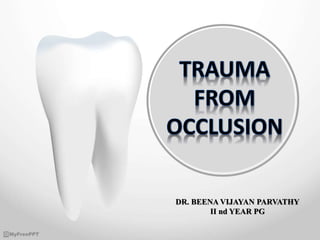Trauma From Occlusion.pptx
- 1. DR. BEENA VIJAYAN PARVATHY II nd YEAR PG
- 2. CONTENTS ŌĆó DEFINITION ŌĆó ETIOLOGY ŌĆó HISTORICAL PRESPECTIVE ŌĆó TERMINOLOGIES WHICH HAVE BEEN USED TO DESCRIBE OCCLSAL TRAUMA ŌĆó REVIEW OF LITERATURE ŌĆó OCCLUSAL FORCES DURING JAW MOVEMENTS ŌĆó CLASSIFICATION ŌĆó STAGES OF TISSUE RESPONSE TO EXCESSIVE OCCLUSAL FORCES ŌĆó EXAMINATION AND DIAGNOSIS
- 3. ŌĆó RADIOGRAPHIC SIGNS ŌĆó IS TRAUMATIC OCCLUSION REVERSIBLE? ŌĆó TRAUMA FROM OCCLUSION ARROUND IMPLANTS ŌĆó OUR PRESENT UNDERSTANDING ŌĆó TREATMENT
- 4. DEFINITION ŌĆó WHO, 1978 ŌĆó GPT, 2001 ŌĆó Jan De Boever, 2004 ŌĆó Carranza, 2006
- 5. ETIOLOGY ŌĆó Precipitating factors (Primary etiology) Destructive occlusal forces Magnitude of force Direction of force Frequency of force Duration of force ŌĆó Predisposing factors Development of TFO indirectly Intrinsic factors Extrinsic factors
- 6. Types of Occlusal Forces ŌĆó Normal physiological forces ŌĆó Impact forces ŌĆó Continuous forces ŌĆó Jiggling forces
- 7. HISTORICAL PRESPECTIVE ŌĆó Karolyi, 1901 ŌĆó BoxŌĆÖs Study, 1935 ŌĆó StoneŌĆÖs Study, 1938 ŌĆó Bhaskar & Orban, 1955
- 8. TERMINOLOGIES WHICH HAVE BEEN USED TO DESCRIBE OCCLUSAL TRAUMA ŌĆó Stillman 1917 ŌĆó Box 1930 ŌĆó Ramfjord & Ash 1972 ŌĆó Muhlemann 1956 Traumatogenic occlusal situation ŌĆó Orban 1958 & Pichard 1965 Periodontal traumatism ŌĆó Glickman 1974 Trauma from Occlusion Traumatic occlusion
- 9. REVIEWOF LITERATURE ŌĆó Stillmann 1917 ’ü▒AUTOPSY STUDIES: ŌĆó Weinman et al ŌĆó GlickmanŌĆÖs Concept:- ŌĆō Glickman & Smulow (1962,1969) ŌĆō Glickman (1963,1965)’āĀ ŌĆ£Theory of Co-destructionŌĆØ
- 11. ŌĆó WaerhaugŌĆÖs Concept ’ü▒ANIMAL STUDY: ŌĆó Rochester Group (Polson & Co-workers) ŌĆó Gothenburg Group (Lindhe & Co-workers) ’ü▒HUMAN TRIALS: ŌĆó Burgett et al 1992 ŌĆó Shefter GJ & Philstrom BL ŌĆó McGuire MK & Nunn ME
- 12. OCCLUSAL FORCES DURING JAW MOVEMENTS ŌĆó Svanberg GK, King GJ & Gibbs CH
- 13. CLASSIFICATION ŌĆó Acute Trauma From Occlusion ŌĆó Chronic Trauma From Occlusion ŌĆó Primary Trauma From Occlusion ŌĆō GPT, AAP 1992 ŌĆō Polson AM, 1976 ŌĆó Secondary Trauma From Occlusion ŌĆō GPT, AAP 1992
- 14. STAGES OF TISSUE RESPONSE TO EXCESSIVE OCCLUSAL FORCES ŌĆó Carranza (1967, 1970) I. Stage I, Injury ŌĆō Slightly excessive forces’āĀ Zaki AE,1963 ŌĆō Greater than slightly excessive force’āĀ Rygh P,1972- 1974) ŌĆō Severly high forces’āĀ Stallard,1964 & Stahl SS,1975) II. Stage II, Repair ’āĀ Buttressing Bone Formation ŌĆō Glickman & Smulov, 1965 ’āĀ Lipping - Glickman & Smulov, 1962
- 15. III. Stage III, Adaptive Remodelling of the Periodontium ŌĆō Lindhe & Ericsson, 1984 ŌĆō Carranza & Dotto, 1966
- 17. EXAMINATION AND DIAGNOSIS Signs of Trauma From Occlusion ŌĆó Tooth Mobility ŌĆó Tooth Migration ŌĆó Wear Patterns ŌĆó Abfraction, especially in premolars ŌĆó V-Shaped or Angled Gingival Recession ŌĆó Fremitus Test ’āĀ Ingervall B, 1972
- 18. Symptoms of Trauma From Occlusion ŌĆó Persistent Discomfort on Eating ŌĆó Thermal Sensitivity ŌĆó Muscle Hypertonicity
- 21. TRAUMA FROM OCCLUSION ARROUND IMPLANTS
- 22. TREATMENT ŌĆó Occlusal adjustments ŌĆó Management of parafunctional habits ŌĆó Splinting of teeth ŌĆó Orthodontic tooth movement ŌĆó Occlusal reconstruction ŌĆó Extraction of selected teeth Perio 2000, 2017
- 24. REFERENCE ŌĆó Role Of Occlusion In The Etiology And Treatment, Of Periodontal Disease, IRVING GLICKMAN, Tufts University School Of Dental Medicine, Boston, Massachusetts 02111, USA. ŌĆó Radiographs In Periodontics, Niklaus P. Langi And Roger W. HILLS, Journal Of Clinical Periodontology: 1977: 4: 16-28. ŌĆó The Infrabony Pocket And Its Relationship To Trauma From Occlusion And Subgingival Plaque By Jens Waerhaug. ŌĆó Role Of Occlusion In Periodontal Disease, Euloir Passanezi, Adriana Campos Passanezi Sant'ana. ŌĆó Association Of Trauma From Occlusion With Localized Gingival Recession In Mandibular Anterior Teeth Pratibha Panduranga Kundapur, Khandige Mahalinga Bhat, And Giliyar Subraya Bhat, Dent Res J (Isfahan). 2009 Autumn; 6(2): 71ŌĆō74. ŌĆó Occlusal Trauma And Excessive Occlusal Forces: Narrative Review, Case De’¼ünitions, And Diagnostic Considerations Jingyuan Fan Jack G. Caton. ŌĆó Clinical Diagnosis Of Trauma From Occlusion And Its Relation With Severity Of Periodontitis L. J. Jtn And C. F. Cao.

























